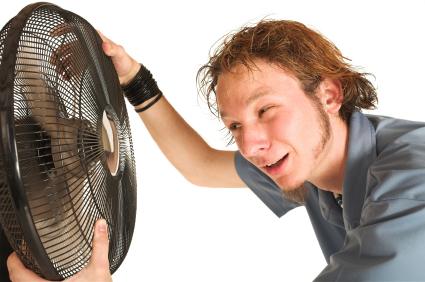Thankfully, the dog days of summer are almost over now, as the temperatures in most places are finally starting to moderate into the range of the tolerable. The summer of 2012 has been the hottest we have seen in quite some time, and unless you have been spending the last three months holed up inside your home with the air conditioner blasting away, the chances are that you and your family have been suffering a good bit.
Of course, for those who live off-the-grid, power supplies are always at a premium, and therefore air conditioning is not really an option in most instances. Or at least, it is not a very practical option, since air conditioners are ranked near the top of the all-time energy hog list, and spending precious electrical resources to run such power-hungry machines is hardly consistent with an energy-efficient lifestyle. For this reason, off-the-gridders who live in climates where extreme summertime heat is an issue – and outside of Alaska, Hawaii, and maybe the Pacific Northwest, that is pretty much everywhere in the United States – should be leaving no stone unturned in their search for low-power and no-power ways to keep their homes cool when the mercury begins to rise.
While this year’s heat wave is now water under the bridge (in the form of a river of sweat), we can only imagine how bad things might get next year. So if you are willing to look ahead, there are a number of changes or modifications you may be able to make to your home and the surrounding homestead that will allow you to beat the heat when it returns with a vengeance in 2013. It wouldn’t be a bad idea at all to start making plans to address that situation now, so that you will be organized and ready to roll with your home renovation project come next spring, before those scorching summertime temperatures have the chance to go soaring into infinity.
Energy-Efficient Alternatives To The Air Conditioner
While the need to save electricity may preclude the use of an air conditioner in most off-the-grid settings, there are a couple of power-drawing technologies that you may still want to consider using to help keep your home more comfortable in the summertime heat.
 Fans of course are the alternative to air conditioners that everyone knows about. How many fans you would like to have going in your house at any one time is up to you, but for the sake of efficiency, you should certainly consider having ceiling fans installed in each and every room where people normally congregate. This low-power, aesthetically pleasing, virtually noiseless type of fan is extremely efficient in its operation and can reduce temperatures in the average room by up to four degrees when kept on for an extended period of time. Ceiling fans can be purchased that turn in either direction, so it is important to make sure you have fans that rotate in a counterclockwise direction in summer, which will create soothing indoor drafts by pulling warm air upwards.
Fans of course are the alternative to air conditioners that everyone knows about. How many fans you would like to have going in your house at any one time is up to you, but for the sake of efficiency, you should certainly consider having ceiling fans installed in each and every room where people normally congregate. This low-power, aesthetically pleasing, virtually noiseless type of fan is extremely efficient in its operation and can reduce temperatures in the average room by up to four degrees when kept on for an extended period of time. Ceiling fans can be purchased that turn in either direction, so it is important to make sure you have fans that rotate in a counterclockwise direction in summer, which will create soothing indoor drafts by pulling warm air upwards.
The most powerful and effective type of ceiling fan is what is known as a whole-house fan. These centrally located machines are actually mounted in the ceiling instead of on it, and they work by drawing hot air upwards and funneling it through into the attic, where it can then be vented into the atmosphere. More sophisticated whole-house fan systems are available that can remove hot air from many rooms simultaneously before venting it through multiple interconnected openings, but the cost of a set-up like this can easily run into the thousands – which could be worth it, depending on how determined you are to keep things cool inside your humble abode.
Evaporative coolers are another possibility for those who are willing to cash in some of their electricity chips to keep their homes livable in summer. The appearance of an evaporative cooler is not all that different from an air conditioner, but rather than relying on the circulation of expensive chemical gases to remove excessive warmth from a room, these coolers instead take advantage of the process by which dry air loses heat whenever it interacts with water and causes it to evaporate. Because it operates by exploiting an entirely natural activity, an evaporative cooler only uses about 25 percent as much electricity as the average air conditioner, which can make it a good option for off-the-gridders living in arid areas where high humidity levels don’t interfere with the evaporative process.
There Is No Such Thing As Too Much Venting
The thing to remember about the ability of moving air to cool warm humans is that as long as air temperatures are below the 98.6-degree threshold at which our bodies normally function, we can always make our homes feel cooler by encouraging good air movement. The best way – really, the only way – to do this without investing precious power resources is to fill our homes with as many holes or openings as possible, arranged in ways that work with prevailing wind patterns and the laws of physics to facilitate the maximum amount of interior air flow.
The most common type of opening in our homes are of course windows, and it is generally true that the more windows we have, the easier it will be to promote effective air passage. But windows aren’t the only choice available for those concerned with interior cooling; vents that allow air to enter on one side of the house and exit on the other are another possibility, and vents have an advantage over windows in that you don’t have to worry about covering them with shades to keep the sunlight from coming in during the hottest part of the day.
Use The Sun To Help Create Your Own Secret Power Plant…
In order to maximize the cooling effects of both windows and vents, there are basically three things that must be done. First, once you know what the prevailing wind patterns in your area are, you will want to make sure that the openings in the walls of your home are set up to work with these patterns and not against them. In other words, if the winds in your area mostly blow from the south to the north, it will not do to have all of your windows installed in the east and west walls, or to have the largest windows on the east and west and smaller windows on the north and south. So when designing a new home or remodeling one that already exists, if good cooling is what you seek then window location is something that you must plan out with intelligence and foresight.
The second thing you must do is make sure that your openings of exit are elevated above your openings of entrance. This is because hot air naturally rises, which means if you let warm summer breezes in at a height of eight feet on the south side but try to sent them back out through vents or windows at a height of four feet on the north side, the air in your home will stagnate instead of flowing freely. Remember, you want to bring the outside air in, but you don’t want it to stick around once it enters your home, so it is important that your arrangement of vents and windows include openings that are higher on the side of exit than on the side of entrance.
The third thing you will need to do to keep air flowing steadily is to put vents, cutouts, or even windows in any walls on the inside of your home that could possibly obstruct the free movement of the air. Few homes are constructed with the principles of smooth and steady airflow in mind, so the idea of adding interior openings is nothing that should be sneezed at.
Roofs Need Venting Too
As previously mentioned, whole-house fans can move air out of a home efficiently by sending it straight up through openings in the attic. But there are several other venting options available for the roofs of homes, and given the irresistible urge that all hot air has to rise, these possibilities should not be overlooked.
Some of the best roof-venting options available include:
- Chimneys – with fireplace or without, chimneys can provide excellent vertical airflow and venting. If you paint the part of the chimney that extends above the roof black, or install a plane of glass at the top facing the southern sun, this will cause air near the top of a chimney to heat and thereby create an even stronger updraft effect than would exist under normal circumstances.
- Operable skylights – they can be shuttered when the sun is shining directly down on them and opened during the hours of the day when it is not.
- Turbine ventilators – these neat devices look like spinning tops sitting on top of the roof as they efficiently suck the warm air up from below.
- Atriums – these will add beauty, a feeling of serenity, and high-quality air movement to any home or indoor space.
- Cupolas – these are dome- or square-shaped rooms that extend upward from the roof of a home. They can be large enough to actually accommodate guests or small enough to provide venting and little else. Cupolas are an attractive architectural innovation that has sadly fallen out of favor, but like atriums, they can improve your house aesthetically at the same time they are improving the interior circulation of air.
Additions to your home like these will obviously require some work and financial investment. But they could very well be worth the expense and effort for those who are truly serious about reducing their indoor suffering index in the months when the outdoor heat index rises into the stratosphere.
Keeping Things Cool On The Outside
Setting up good natural air flow is all well and good, but of course the cooler the air is when it enters your home the more effective it will be at keeping your family cool as it passes through. Shade trees that can provide shelter from the southern sun will help reduce the temperature of the air before it enters your home, and large overhangs or awnings that can keep windows in shadows will do the same. Generally speaking, the more shade you have on your homestead, the cooler things will be, so this is something you should always keep in mind when you are picking a building location or making plans for your surrounding landscape.
Another excellent way to reduce air temperature is to install a pond or fountain near your home, preferably on the side of the house facing into the wind. As we have already seen in our discussion of evaporative coolers, dry air loses heat as it evaporates water, so any time moving air sweeps across a watery surface, it will be cooled quite efficiently and effectively. In a humid climate, this would not work very well since the air is already saturated with moisture, but in an arid climate putting in a pond or a fountain can be an excellent way to help reduce the temperatures of a breeze before it actually enters a home.
One last trick is to landscape your exterior so that the trees and shrubs and outbuildings will naturally channel and concentrate the prevailing winds toward the house. And if the objects used to create this effect are tall enough to provide some shadow as well, then so much the better.
©2012 Off the Grid News










